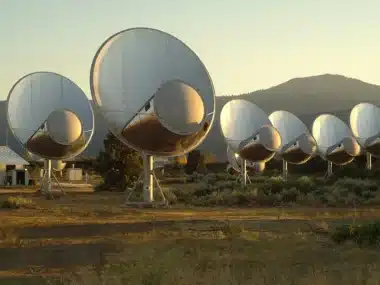A team of scientists from the SETI Institute and Penn State University has completed the longest search ever for alien radio signals from the TRAPPIST-1 star system, located 41 light-years from Earth.
Scientists Search for Alien Radio Signals in the TRAPPIST-1 System

Scientists from the SETI Institute and Penn State University have completed the most thorough search for alien radio signals from the TRAPPIST-1 star system to date. Using the Allen Telescope Array (ATA), they scanned the system for 28 hours, looking for signs of intelligent life.
TRAPPIST-1: A Prime Candidate in the Search for Life
Located just 41 light-years from Earth, TRAPPIST-1 is a star system in the constellation Aquarius that has become a focal point in the search for life beyond our solar system. The system is composed of seven rocky planets, several of which lie within the star's habitable zone—the region where conditions might allow for liquid water to exist on the surface. This is a crucial factor when considering the potential for life, making TRAPPIST-1 an exciting target for astronomers.
The recent study marks the longest single-target radio search ever conducted on this system. Researchers used the upgraded Allen Telescope Array to look for technosignatures—narrowband radio signals that might indicate the presence of alien technology. These signals could be evidence of advanced civilizations sending out communications or even unintentionally leaking radio waves.
“TRAPPIST-1 remains one of the most promising places in the search for extraterrestrial life,” said Nick Tusay, a graduate research fellow at Penn State University. “We know that several planets in this system are in the habitable zone, which makes it a prime candidate for these types of searches.”
The ATA's enhanced software allowed the team to analyze millions of potential signals, narrowing them down to approximately 11,000 candidates. Among these, 2,264 signals were detected during planet-planet occultations (PPOs)—a phenomenon in which one planet passes in front of another. If an advanced civilization existed in the system, the radio signals sent between planets during such events could theoretically be detected from Earth. However, none of the signals were determined to be of non-human origin, and no signs of alien life were confirmed.
Technological Advances and New Methods for Detecting Alien Life
Despite the absence of alien signals, the study represents a significant advancement in how scientists conduct searches for extraterrestrial intelligence. The Allen Telescope Array, located in California’s Lassen National Forest, is a key tool in these efforts, and its recent upgrades have allowed for more precise scanning of distant star systems. The team focused particularly on narrowband signals, which are considered strong indicators of technological activity if detected from other star systems.
One of the key methods used in this study was the observation of planet-planet occultations, a relatively new approach in the field. By scanning during these events, scientists believe they can increase their chances of detecting signals that might otherwise go unnoticed. “Most searches assume some intent, like beacons,” explained Tusay. “Our receivers have a sensitivity limit to a minimum transmitter power, which means we can only detect certain types of signals with our current equipment. But with better tools, like the Square Kilometer Array (SKA), we might soon be able to detect signals from an alien civilization communicating with its spacecraft.”
The SKA, a highly anticipated $2.2 billion project, is set to revolutionize the field of radio astronomy when it becomes operational in the coming years. This ambitious array will consist of over 130,000 antennas in Western Australia and nearly 200 radio dishes in South Africa. By covering a total area of one square kilometer, the SKA will have the capability to detect extremely faint signals that current telescopes cannot pick up. The sensitivity of the SKA could allow astronomers to detect not only intentional signals, like beacons, but also unintentional leaks of radio waves from civilizations far beyond our solar system.
The prospect of this new technology has energized researchers. “This research shows we are getting closer to detecting radio signals similar to the ones we send into space,” said Tusay. “Once the SKA is operational, we’ll have the ability to explore even further into the cosmos and potentially discover evidence of intelligent life.”

Continuing the Search for Extraterrestrial Signals
While no technosignatures were discovered during this study, it has laid a valuable foundation for future research. The SETI Institute and its partners remain committed to improving their search techniques and expanding their focus to other star systems that may harbor life. The TRAPPIST-1 system, with its Earth-sized planets and potential for liquid water, will continue to be a top target for astronomers in the years to come.
The results of the study, which have been published as a preprint and are awaiting peer review in the Astronomical Journal, highlight the importance of refining methodologies and developing better equipment. The team is optimistic that future searches will yield even more promising results as more powerful telescopes, such as the SKA, become available.
Tusay emphasized the long-term nature of the search: “We didn’t find anything this time, but every step we take brings us closer to understanding the universe. With the advancements in technology and our new methods, I’m confident that we’ll eventually detect signals from another civilization. It’s just a matter of time.”



